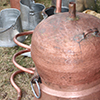Invisible alcohol consumption
Alcohol consumption from unofficial sources in two districts
DOI:
https://doi.org/10.18030/socio.hu.2024.3.44Keywords:
alcohol consumption, unregistered alcohol consumption, home-distilled pálinka, alcohol smugglingAbstract
Background and purpose of the study: The estimation of unregistered alcohol consumption that does not appear in official statistics has long been a topic of research in the alcohol literature, as the amount of unregistered consumption may have a significant impact on the conclusions drawn from official statistics. The traditional sources of unregistered consumption in Hungary are home-distilled pálinka and wine production, but smuggling has also sometimes played a significant role, especially in the post-transition period but also today too, in some border regions. Many national experts explain the decline in alcohol consumption recorded in official statistics by the increase in unregistered alcohol consumption, which is presumably due to more permissive regulation of home distilling. According to previous national and international estimates, the proportion of unregistered consumption within total domestic alcohol consumption is somewhere between 0.5 and 40%.
Purpose of the study: In our study, we wanted to find out the prevalence of consumption of alcoholic beverages from unregistered sources, the sources of consumption consumers rely on, as well as to identify the social groups among which unregistered alcohol consumption is more prevalent and to define the contribution of unregistered alcohol to the overall consumption of the respondents.
Methodology: A face-to-face questionnaire survey was conducted in two disadvantaged districts in Hungary (Siklós district and Záhony district) to examine the characteristics of unregistered consumption. Cross-tabulation analyses, Chi-square tests, and binary logistic regression analysis were used to examine the effect of social-demographic factors.
Results: Both districts have a high proportion of unregistered alcohol consumption within the general population and it accounts for a significant proportion of the total alcohol consumption of the population. According to our estimation, at least a quarter of the alcohol consumed in these districts comes from unofficial sources. Homebrewing or contract brewing of spirits is dominant. Obtaining alcohol from an unregistered source is clearly linked to higher and more frequent consumption. Our data show that unregistered consumption is not exclusively related to low social status. At the same time, however, the use of these sources is likely to be more prevalent among older men living in villages.





